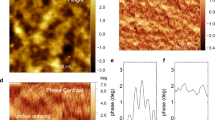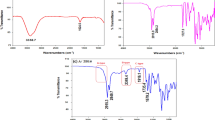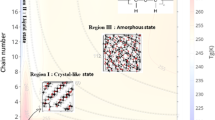Abstract
Supramolecular films consisting of guanosine derivatives modified with a tetrathiafulvalene (TTF) moiety have been prepared. The hydrogen bonding network of the guanosine unit enables the formation of a robust and self-supporting cast film by a solution process. Differential scanning calorimetry and dynamic mechanical analysis (DMA) revealed that the self-supporting films were mechanically flexible and their glass transition temperature was lower than room temperature. The results of the DMA also showed the viscoelastic properties of the films at room temperature. The physical properties of the films of the derivatives depended on both the length of the alkyl chains and the structure of their terminal group. The chemical oxidation of the derivatives resulted in the formation of the absorption band due to the radical cationic TTF moiety. The composite film of the derivatives with 7,7,8,8,-tetracyanoquinodimethane exhibited electrical conductivity.
Similar content being viewed by others
Log in or create a free account to read this content
Gain free access to this article, as well as selected content from this journal and more on nature.com
or
References
Ferraris, J., Cowan, D. O., Walatka, V. & Perlstein, J. H. Electron transfer in a new highly conducting donor-acceptor complex. J. Am. Chem. Soc. 95, 948–949 (1973).
Alves, H., Molinari, A. S., Xie, H. & Morpurge, A. F. Metallic conduction at organic charge-transfer interfaces. Nat. Mater 7, 574–580 (2008).
Perlstein, J. H. "Organic Metals"-the intermolecular migration of aromaticity. Angew. Chem. Int. Ed. Engl. 16, 519–534 (1977).
Inagi, S., Naka, K. & Chujo, Y. Functional polymers based on electron-donating TTF and derivatives. J. Mater. Chem. 17, 4122–4135 (2007).
Hertler, W. R. Charge-transfer polymers containing 7,7,8,8-tetracyanoquinodimethan and tetrathiafulvalene. J. Org. Chem. 41, 1412–1416 (1976).
Green, D. C. & Allen, R. W. Vinyltetrathiafulvalene. J. Chem. Soc. Chem. Commun. 832–833 (1978).
Kaplan, M. L., Haddon, R. C., Wudl, F. & Feit, E. D. Preparation of some monophenyltetrathiafulvalenes and (p-vinylphenyl)tetrathiafulvalene and its polymerization. J. Org. Chem. 43, 4642–4646 (1978).
Frenzel, S., Baumgarten, M. & Müllen, K. Rod-like tetrathiafulvalene polymers with extended π-conjugation. Synth. Met. 118, 97–103 (2001).
Pittman, C. U., Ueda, M. & Liang, Y. Syntheses of poly(urethanes) and poly(sulfonates) containing tetrathiafulvalene nuclei in the backbone. J. Org. Chem. 44, 3639–3642 (1979).
Frenzel, S., Arndt, S., Gregorious, R. M. & Müllen, K. Synthesis of tetrathiafulvalene polymers. J. Mater. Chem. 5, 1529–1537 (1995).
Shimizu, T. & Yamamoto, T. Preparation of a new poly(arylacetylene) with a tetrathiafulvalene (TTF) unit in the side chain. Chem. Commun. 515–516 (1999).
Iyoda, M., Hasegawa, M. & Enozawa, H. Self-assembly and nanostructure formation of mulkti-funtional organic π-donors. Chem. Lett. 36, 1402–1407 (2007).
Naka, K., Ando, D., Wang, X. & Chujo, Y. Synthesis of organic-metal hybrid nanowires by cooperative self-organization of tetrathiafulvalene and metallic gold via charge-transfer. Langmuir 23, 3450–3454 (2007).
Kitahara, T., Shirakawa, M., Kawano, S., Bejinn, U., Fujita, N. & Shinkai, S. Creation of a mixed-valence state from one-dimensionally aligned TTF utilizing the self-assembling nature of a low molecular-weight gel. J. Am. Chem. Soc. 127, 14980–14981 (2005).
Kitamura, T., Nakaso, S., Mizoshita, N., Tochigi, Y., Shimomura, T., Moriyama, M., Ito, K. & Kato, T. Electroactive supramolecular self-assembled fibers comprised of doped tetrathiafulvalene-based gelators. J. Am. Chem. Soc. 127, 14769–14775 (2005).
Tatewaki, Y., Hatanaka, T., Tsunashima, R., Nakamura, T., Kimura, M. & Shirai, H. Conductive nanoscopic fibrous assemblies containing helical tetrathiafulvalene stacks. Chem. Asian. J. 4, 1474–1479 (2009).
Hasegawa, M., Enozawa, H., Kawabata, Y. & Iyoda, M. Hexagonally ordered nanostructures comprised of a flexible disk-like molecule with high self-assembling properties at neutral and cationic states. J. Am. Chem. Soc. 129, 3072–3073 (2007).
Choi, S. J., Kuwabara, J. & Kanbara, T. Electrically Conductive hydrogen-bond-based supramolecular polymer with tetrathiafulvalene moiety: modulation of electrical conductivity and flexibility of film by external stimulus. Chem. Asian J. 5, 2154–2157 (2010).
Davis, J. T. & Spada, G. P. Supramolecular architectures generated by self-assembly of guanosine derivatives. Chem. Soc. Rev. 36, 296–313 (2007).
Araki, K. & Yoshikawa, I. Nucleobase-containing gelators. Top. Curr. Chem. 256, 133–165 (2005).
Yoshikawa, I., Li, J., Sakata, Y. & Araki, K. Design and fabrication of a flexible and self-supporting supramolecular film by hierarchical control of the interaction between hydrogen-bonded sheet assemblies. Angew. Chem., Int. Ed. 43, 100–103 (2004).
Araki, K., Takasawa, R. & Yoshikawa, I. Design, fabrication, and properties of macroscalesupramolecular fibers consisted of fully hydrogen-bonded pseudo-polymerchains. Chem. Commun. 1826–1827 (2001).
Gottarelli, G., Masiero, S., Mezzina, E., Pieraccini, S., Rabe, J. P., Samorì, P. & Spada, G. P. The self-assembly of lipophilic guanosine derivatives in solution and on solid surfaces. Chem. Eur. J. 6, 3242–3248 (2000).
Spada, G. P., Lena, S., Masiero, S., Pieraccini, S., Surin, M. & Samorì, P. Guanosine based H-bonded scaffolds: controlling the assembly of oligothiophenes. Adv. Mater 20, 2433–2438 (2008).
Yoshikawa, I., Yanagi, S., Yamaji, Y. & Araki, K. Nucleoside-based organogelators: gelation by the G-G base pair formation of alkylsilylated guanosine derivatives. Tetrahedron 63, 7474–7481 (2007).
Takasawa, R., Yoshikawa, I. & Araki, K. Use of an adjustable soft segment as an effective molecular design for crystal engineering of hydrogen-bonded tape motifs. Org. Biomol. Chem. 2, 1125–1132 (2004).
Tanaka, K., Ishiguro, F. & Chujo, Y. Facile preparation of concentration-gradient materials with radical spin of the mixed-valence tetrathiafulvalene in conventional polymer films. Langmuir 26, 10254–10258 (2010).
Bower, D. I. An Introduction to Polymer physics, (Cambridge University Press, New York, 2002).
Menard, K. P. Dynamic Mechanical Analysis: A Practical Introduction 2nd Edition (CRC Press, Boca Raton,, 2008).
Gosline, J., Lille, M. & Carrington, E. Guerette, P ., Ortlepp, C . & Savage, K . Elastic proteins biological role and mechanical properties Phil. Trans. R. Soc. Lond. B 357, 121–132 (2002).
Zhou, Y., Wu, H., Qu, L., Zhang, D. & Zhu, D. A new redox-resettable molecule-based half-adder with tetrathiafulvalene. J. Phys. Chem. B 110, 15676–15679 (2006).
Torrance, J. B., Scott, B. A., Welber, B., Kaufman, F. B. & Seiden, P. E. Optical properties of the radical cation tetrathiafulvalenium (TTF+) in its mixed-valence and monovalence halide salts. Phys. Rev. B 19, 730–741 (1979).
Ziganshina, A. Y., Ko, Y. H., Jeon, W. S. & Kim, K. Stable π-dimer of a tetrathiafulvalene cation radical encapsulated in the cavity of cucurbit[8]uri. Chem. Commun. 806–807 (2004).
Yoshikawa, I., Sawayama, J. & Araki, K. Highly stable giant supramolecular vesicles composed of 2D hydrogen-bonded sheet structures of guanosine derivatives. Angew. Chem. Int. Ed. 47, 1038–1041 (2008).
Giorgi, T., Grepioni, F., Manet, I., Mariani, P., Masiero, S., Mezzina, E., Pieraccini, S., Saturni, L., Spada, G. P. & Gottarelli, G. Gel-like lyomesophases formed in organic solvents by self-assembled guanine ribbons. Chem. Eur. J. 8, 2143–2151 (2002).
Fraxedas, J., Molas, S., Figueras, A., Jiménez, I., Gago, R., Auban-Senzier, P. & Goffman, M. Thin films of molecular metals: TTF-TCNQ. J. Solid State Chem. 168, 384–389 (2002).
Acknowledgements
This work was partly supported by Grants-in-Aid for Scientific Research from the Ministry of Education, Culture, Sports, Science and Technology, Japan. The Circle for the promotion of science and Engineering is acknowledged for the financial support. The authors are grateful to the Chemical Analysis Center of University of Tsukuba for elemental analyses and NMR spectroscopy. The authors are grateful thank to Mr T Aikawa and Mr J Kanai in TA Instruments for the measurements of DMA. Professor Y Otsuka and Mr Y Shoji are acknowledged for technical supports of the measurements of electrical conductivity.
Author information
Authors and Affiliations
Corresponding author
Additional information
Supplementary Information accompanies the paper on Polymer Journal website
Supplementary information
Rights and permissions
About this article
Cite this article
Choi, S., Kuwabara, J. & Kanbara, T. Physical and electrical characteristics of supramolecular polymer films based on guanosine derivatives modified with tetrathiafulvalene moiety. Polym J 44, 946–951 (2012). https://doi.org/10.1038/pj.2012.47
Received:
Revised:
Accepted:
Published:
Issue date:
DOI: https://doi.org/10.1038/pj.2012.47



